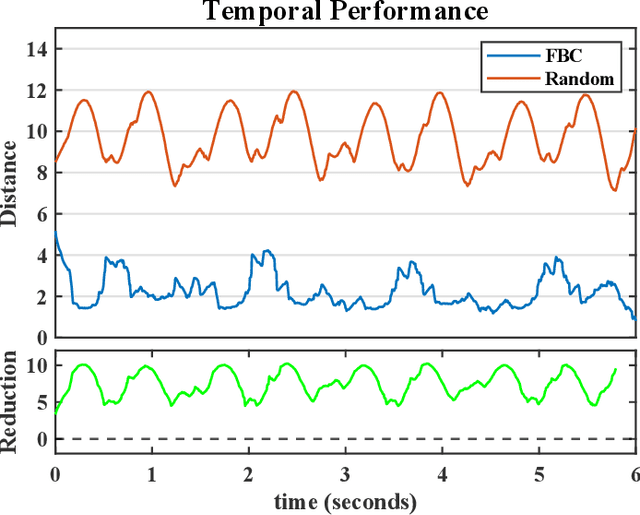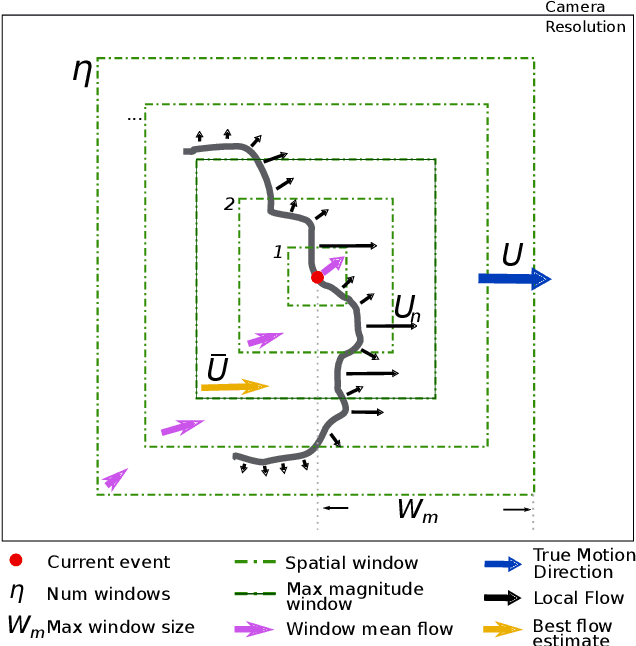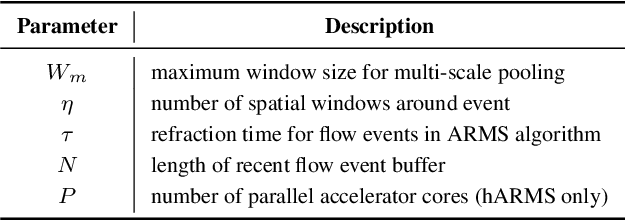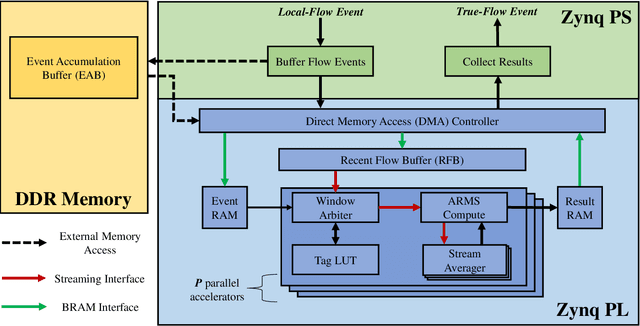Daniel C. Stumpp
Flow-Based Visual Stream Compression for Event Cameras
Mar 12, 2024



Abstract:As the use of neuromorphic, event-based vision sensors expands, the need for compression of their output streams has increased. While their operational principle ensures event streams are spatially sparse, the high temporal resolution of the sensors can result in high data rates from the sensor depending on scene dynamics. For systems operating in communication-bandwidth-constrained and power-constrained environments, it is essential to compress these streams before transmitting them to a remote receiver. Therefore, we introduce a flow-based method for the real-time asynchronous compression of event streams as they are generated. This method leverages real-time optical flow estimates to predict future events without needing to transmit them, therefore, drastically reducing the amount of data transmitted. The flow-based compression introduced is evaluated using a variety of methods including spatiotemporal distance between event streams. The introduced method itself is shown to achieve an average compression ratio of 2.81 on a variety of event-camera datasets with the evaluation configuration used. That compression is achieved with a median temporal error of 0.48 ms and an average spatiotemporal event-stream distance of 3.07. When combined with LZMA compression for non-real-time applications, our method can achieve state-of-the-art average compression ratios ranging from 10.45 to 17.24. Additionally, we demonstrate that the proposed prediction algorithm is capable of performing real-time, low-latency event prediction.
Efficient and Low-Footprint Object Classification using Spatial Contrast
Nov 06, 2023Abstract:Event-based vision sensors traditionally compute temporal contrast that offers potential for low-power and low-latency sensing and computing. In this research, an alternative paradigm for event-based sensors using localized spatial contrast (SC) under two different thresholding techniques, relative and absolute, is investigated. Given the slow maturity of spatial contrast in comparison to temporal-based sensors, a theoretical simulated output of such a hardware sensor is explored. Furthermore, we evaluate traffic sign classification using the German Traffic Sign dataset (GTSRB) with well-known Deep Neural Networks (DNNs). This study shows that spatial contrast can effectively capture salient image features needed for classification using a Binarized DNN with significant reduction in input data usage (at least 12X) and memory resources (17.5X), compared to high precision RGB images and DNN, with only a small loss (~2%) in macro F1-score. Binarized MicronNet achieves an F1-score of 94.4% using spatial contrast, compared to only 56.3% when using RGB input images. Thus, SC offers great promise for deployment in power and resource constrained edge computing environments.
hARMS: A Hardware Acceleration Architecture for Real-Time Event-Based Optical Flow
Dec 13, 2021



Abstract:Event-based vision sensors produce asynchronous event streams with high temporal resolution based on changes in the visual scene. The properties of these sensors allow for accurate and fast calculation of optical flow as events are generated. Existing solutions for calculating optical flow from event data either fail to capture the true direction of motion due to the aperture problem, do not use the high temporal resolution of the sensor, or are too computationally expensive to be run in real time on embedded platforms. In this research, we first present a faster version of our previous algorithm, ARMS (Aperture Robust Multi-Scale flow). The new optimized software version (fARMS) significantly improves throughput on a traditional CPU. Further, we present hARMS, a hardware realization of the fARMS algorithm allowing for real-time computation of true flow on low-power, embedded platforms. The proposed hARMS architecture targets hybrid system-on-chip devices and was designed to maximize configurability and throughput. The hardware architecture and fARMS algorithm were developed with asynchronous neuromorphic processing in mind, abandoning the common use of an event frame and instead operating using only a small history of relevant events, allowing latency to scale independently of the sensor resolution. This change in processing paradigm improved the estimation of flow directions by up to 73% compared to the existing method and yielded a demonstrated hARMS throughput of up to 1.21 Mevent/s on the benchmark configuration selected. This throughput enables real-time performance and makes it the fastest known realization of aperture-robust, event-based optical flow to date.
 Add to Chrome
Add to Chrome Add to Firefox
Add to Firefox Add to Edge
Add to Edge